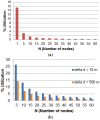A proposed scalable design and simulation of wireless sensor network-based long-distance water pipeline leakage monitoring system
- PMID: 24561404
- PMCID: PMC3958258
- DOI: 10.3390/s140203557
A proposed scalable design and simulation of wireless sensor network-based long-distance water pipeline leakage monitoring system
Abstract
Anomalies such as leakage and bursts in water pipelines have severe consequences for the environment and the economy. To ensure the reliability of water pipelines, they must be monitored effectively. Wireless Sensor Networks (WSNs) have emerged as an effective technology for monitoring critical infrastructure such as water, oil and gas pipelines. In this paper, we present a scalable design and simulation of a water pipeline leakage monitoring system using Radio Frequency IDentification (RFID) and WSN technology. The proposed design targets long-distance aboveground water pipelines that have special considerations for maintenance, energy consumption and cost. The design is based on deploying a group of mobile wireless sensor nodes inside the pipeline and allowing them to work cooperatively according to a prescheduled order. Under this mechanism, only one node is active at a time, while the other nodes are sleeping. The node whose turn is next wakes up according to one of three wakeup techniques: location-based, time-based and interrupt-driven. In this paper, mathematical models are derived for each technique to estimate the corresponding energy consumption and memory size requirements. The proposed equations are analyzed and the results are validated using simulation.
Figures









References
-
- Cataldo A., Cannazza G., Benedetto E.D., Giaquinto N. A new method for detecting leaks in underground water pipelines. IEEE Sens. J. 2012;12:1660–1667.
-
- BenSaleh M.S., Qasim S.M., Obeid A.M., Garcia-Ortiz A. A Review on Wireless Sensor Network for Water Pipeline Monitoring Applications. Proceedings of the International Conference on Collaboration Technologies and Systems (CTS'2013); San Diego, CA, USA. 20–24 May 2013; pp. 128–131.
-
- Seddiq Y.M., Alotaibi A.M., Al-nasheri A.Y., Almazyad A.S., BenSaleh M.S., Qasim S.M. Evaluation of Energy-Efficient Cooperative Scheme for Wireless Sensor Nodes used in Long Distance Water Pipeline Monitoring Systems. Proceedings of Fifth International Conference on Computational Intelligence, Communication Systems and Networks (CiCSyn'2013); Madrid, Spain. 5–7 June 2013; pp. 107–111.
-
- Jin Y.W., Eydgahi A. Monitoring of Distributed Pipeline Systems by Wireless Sensor Networks. Proceedings of the 2008 IAJC-IJME International Conference; Nashville, TN, USA. 17–19 November 2008; pp. 1–10.
-
- Sinha D.N. Acoustic sensor for pipeline monitoring, Technical Report, LA-UR-05–6025. Los Alamos National Laboratory: Los Alamos; New Mexico, USA: Jul 20, 2005. pp. 1–23.
Publication types
LinkOut - more resources
Full Text Sources
Other Literature Sources

